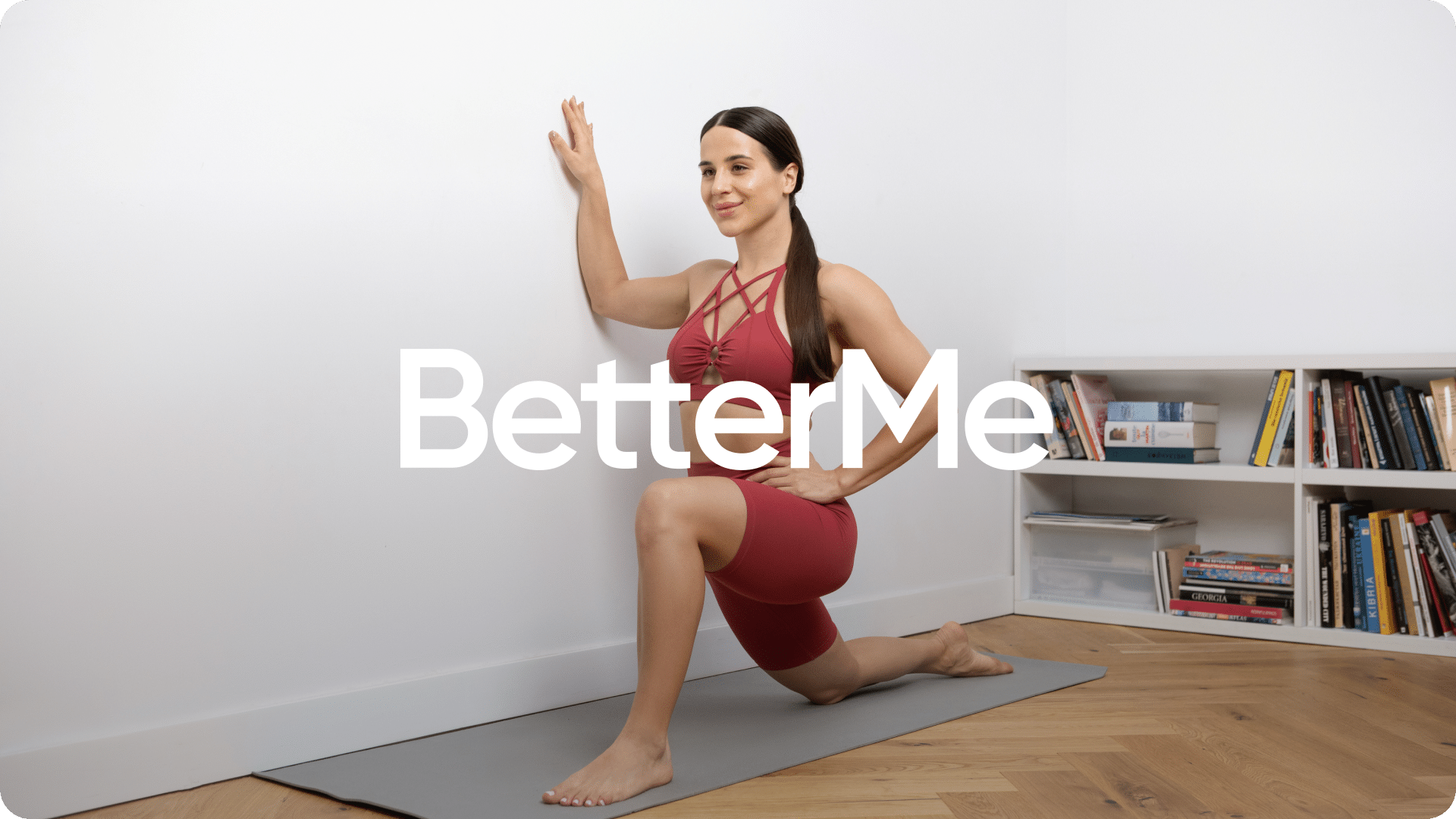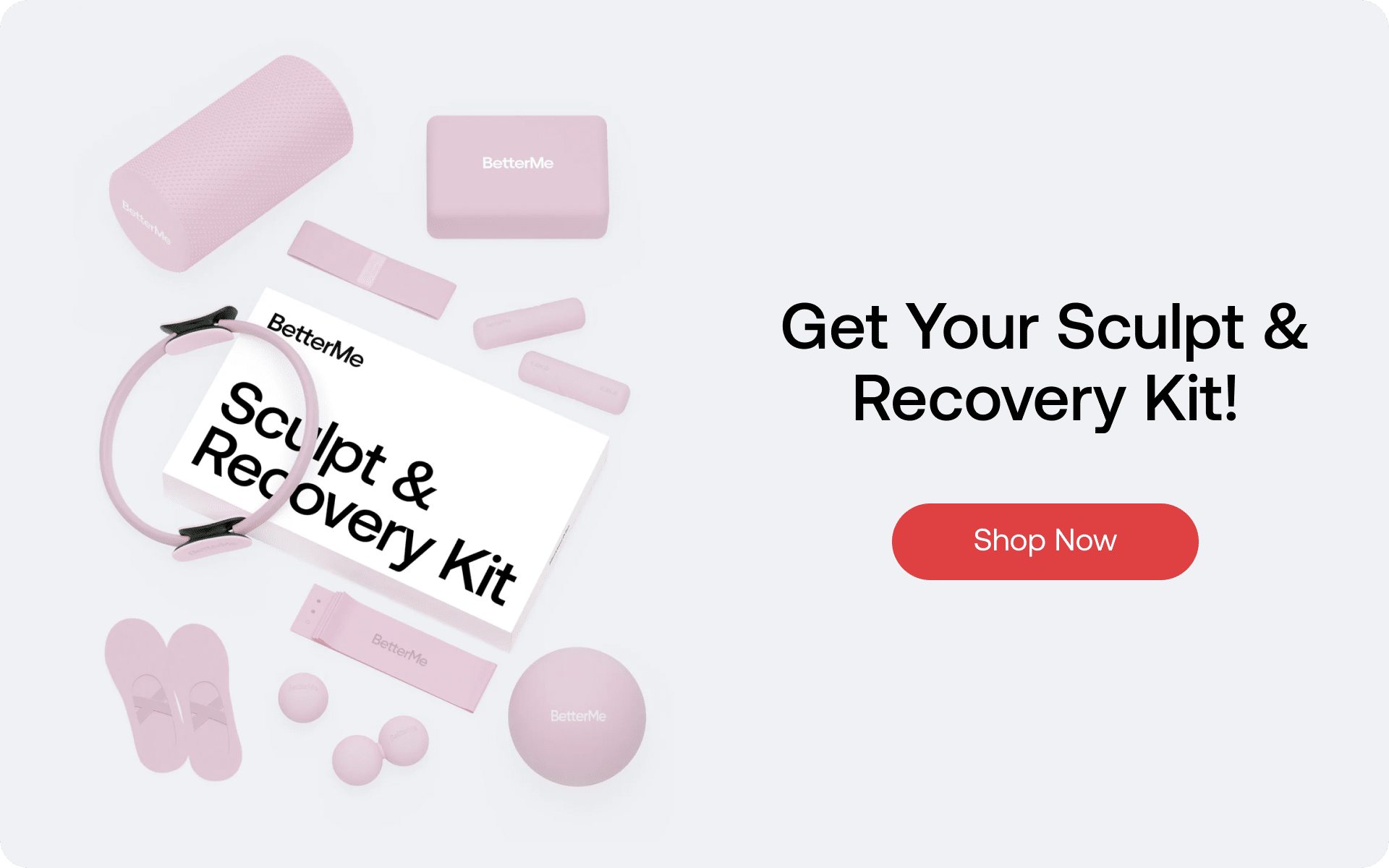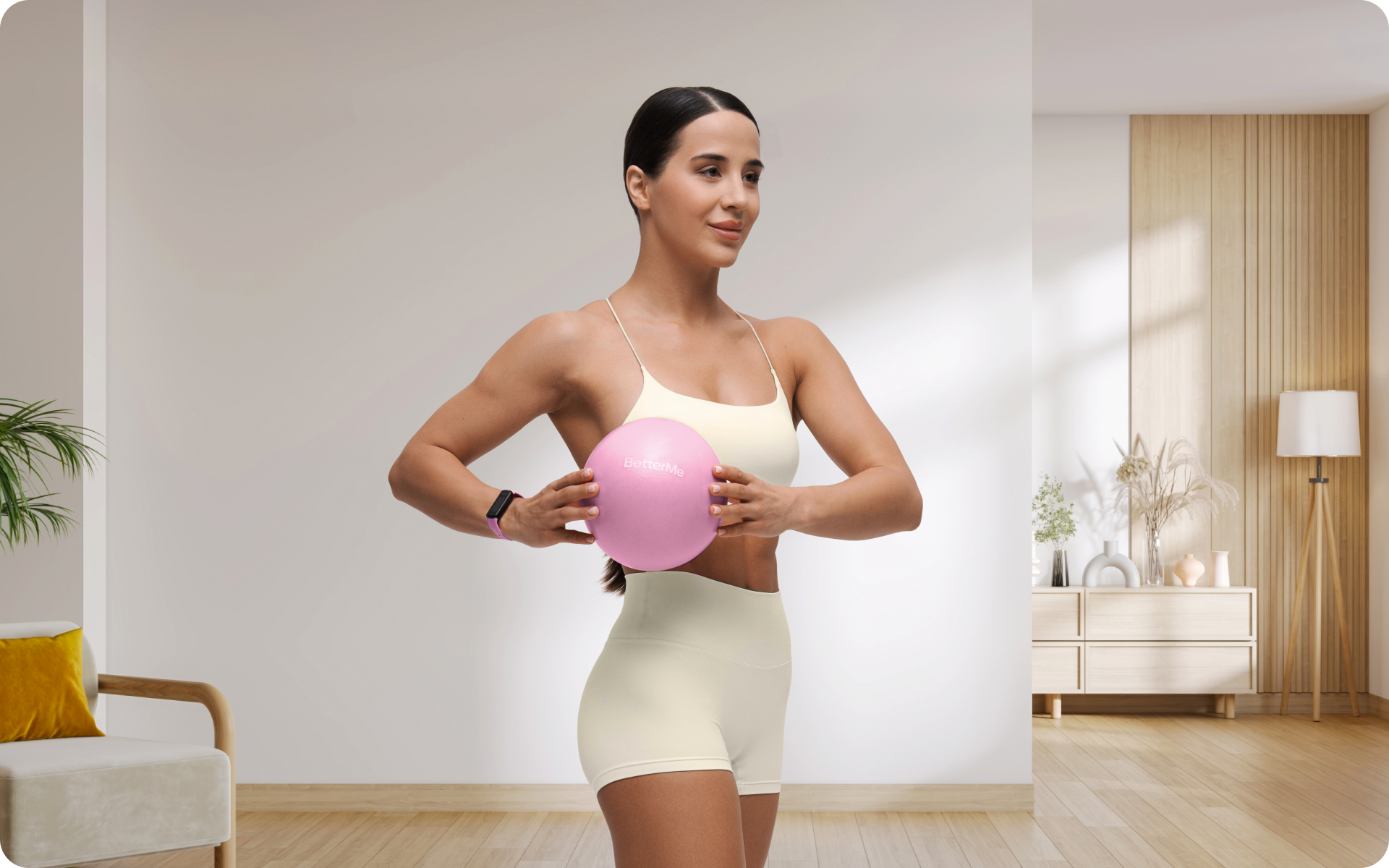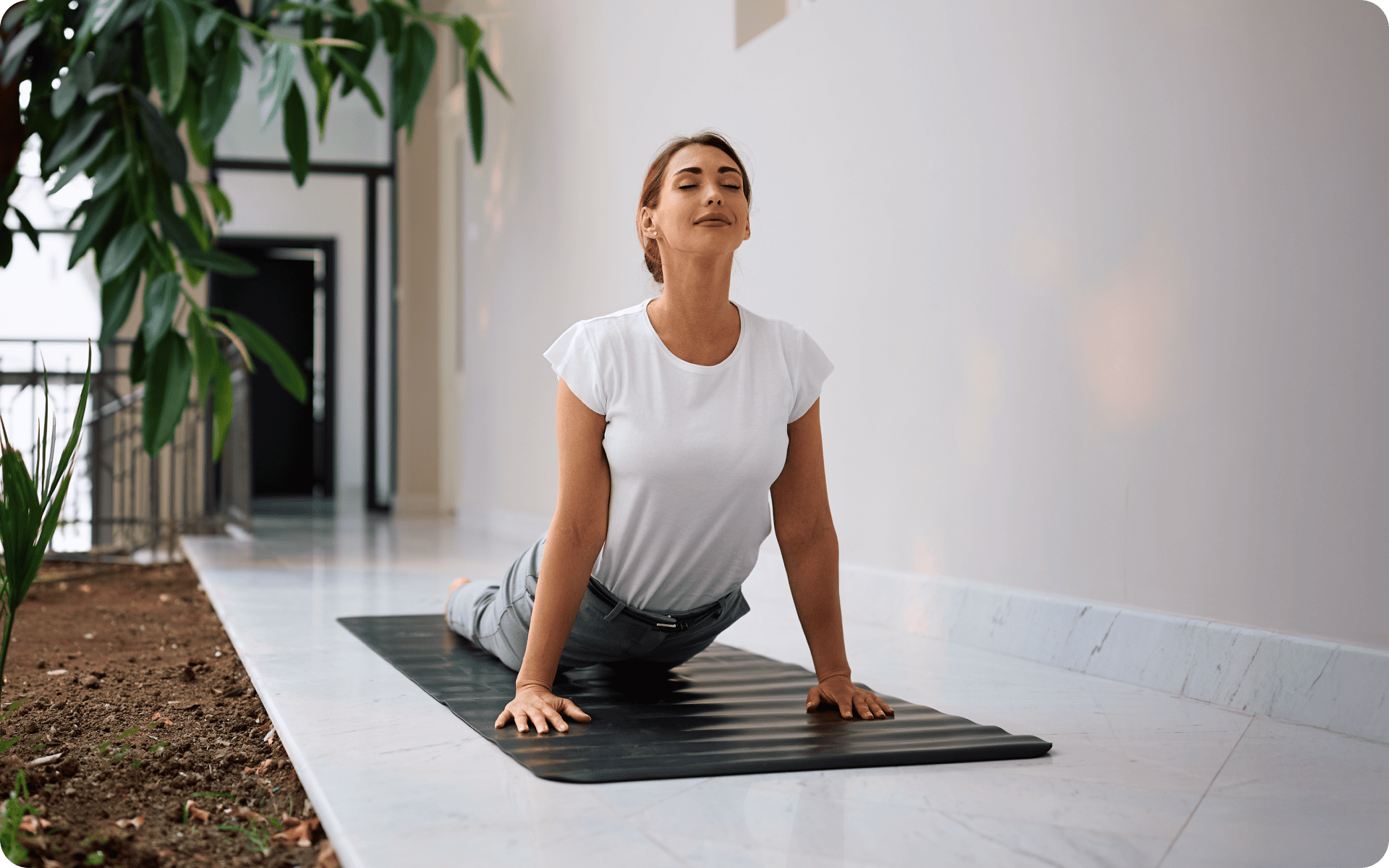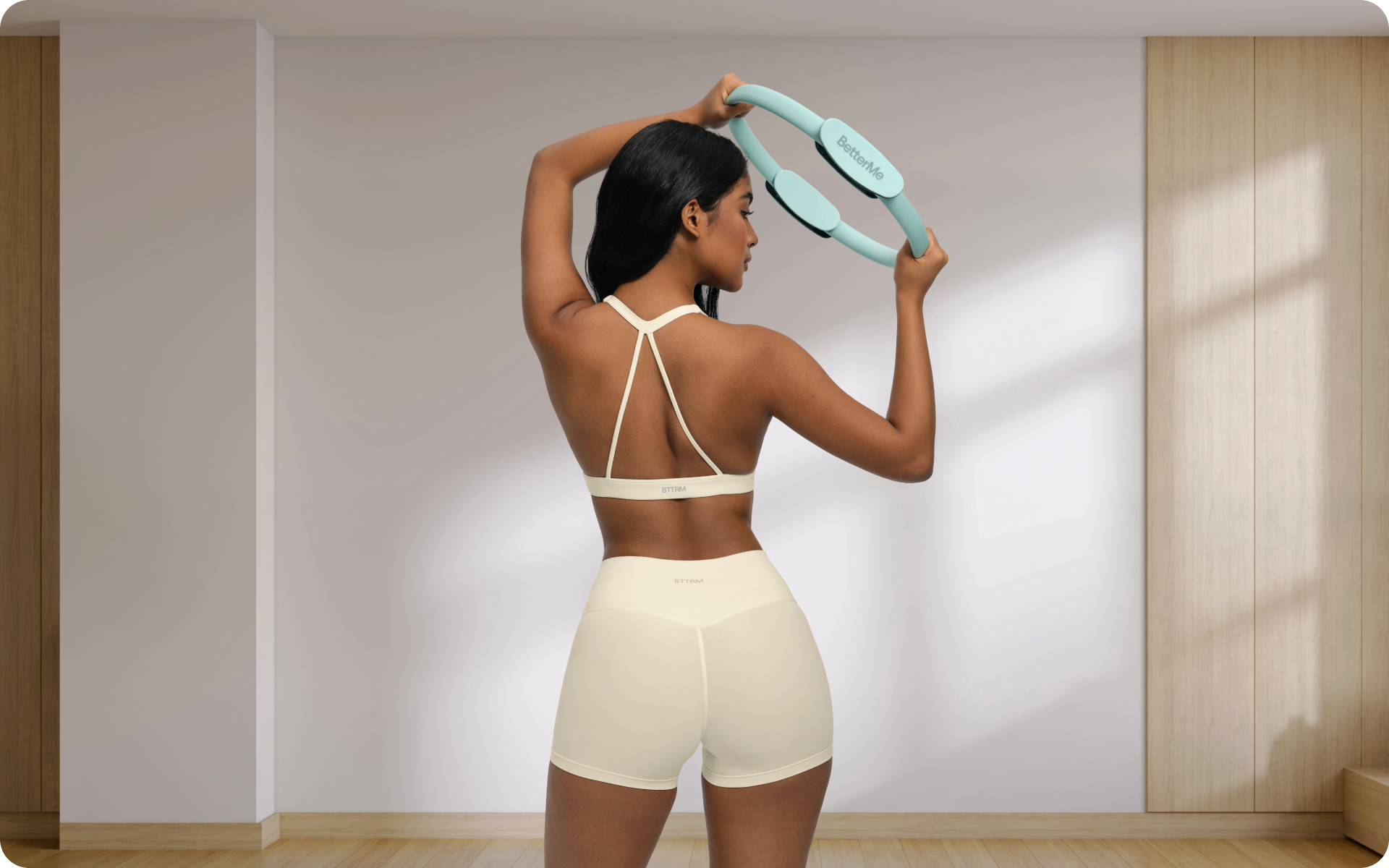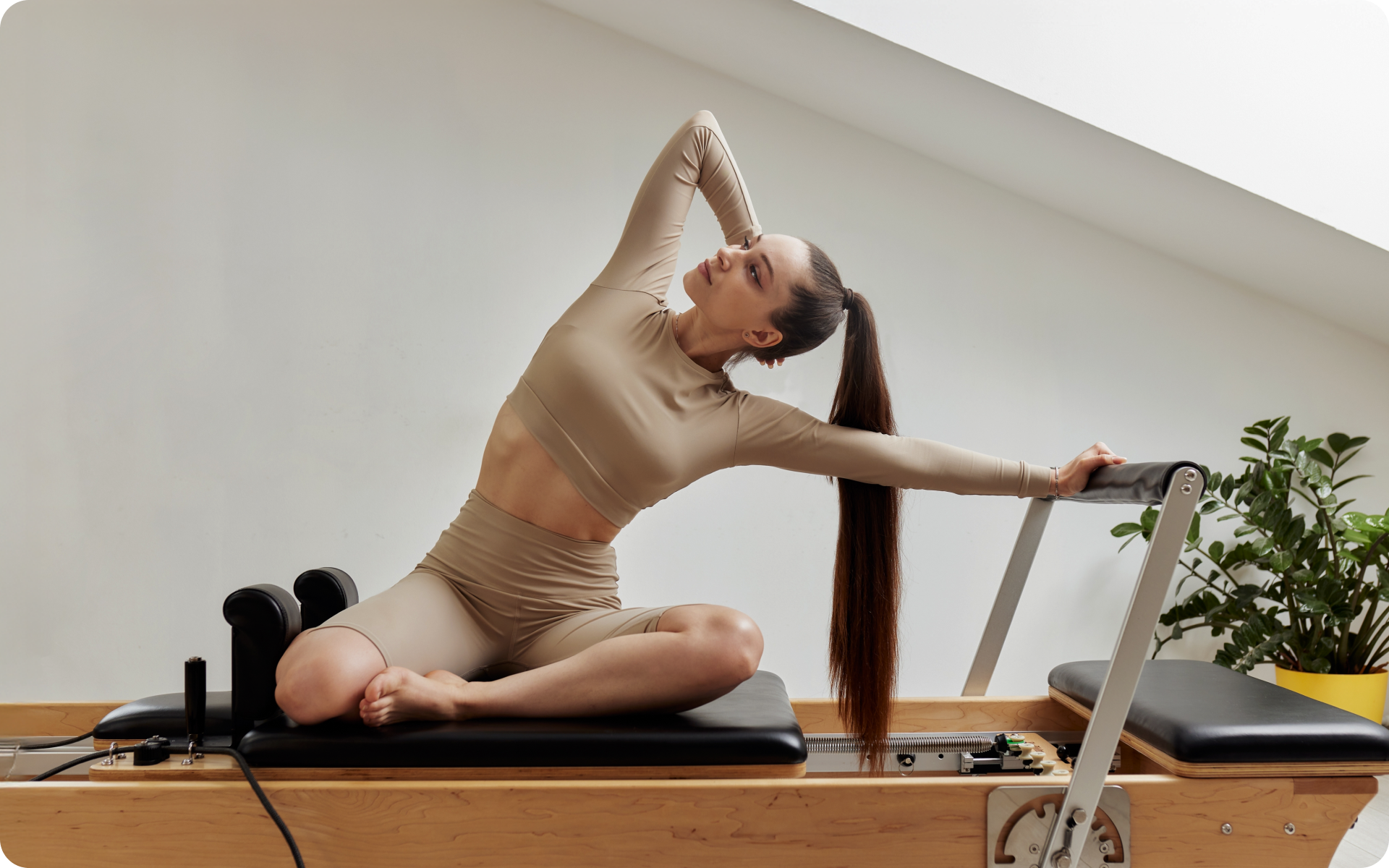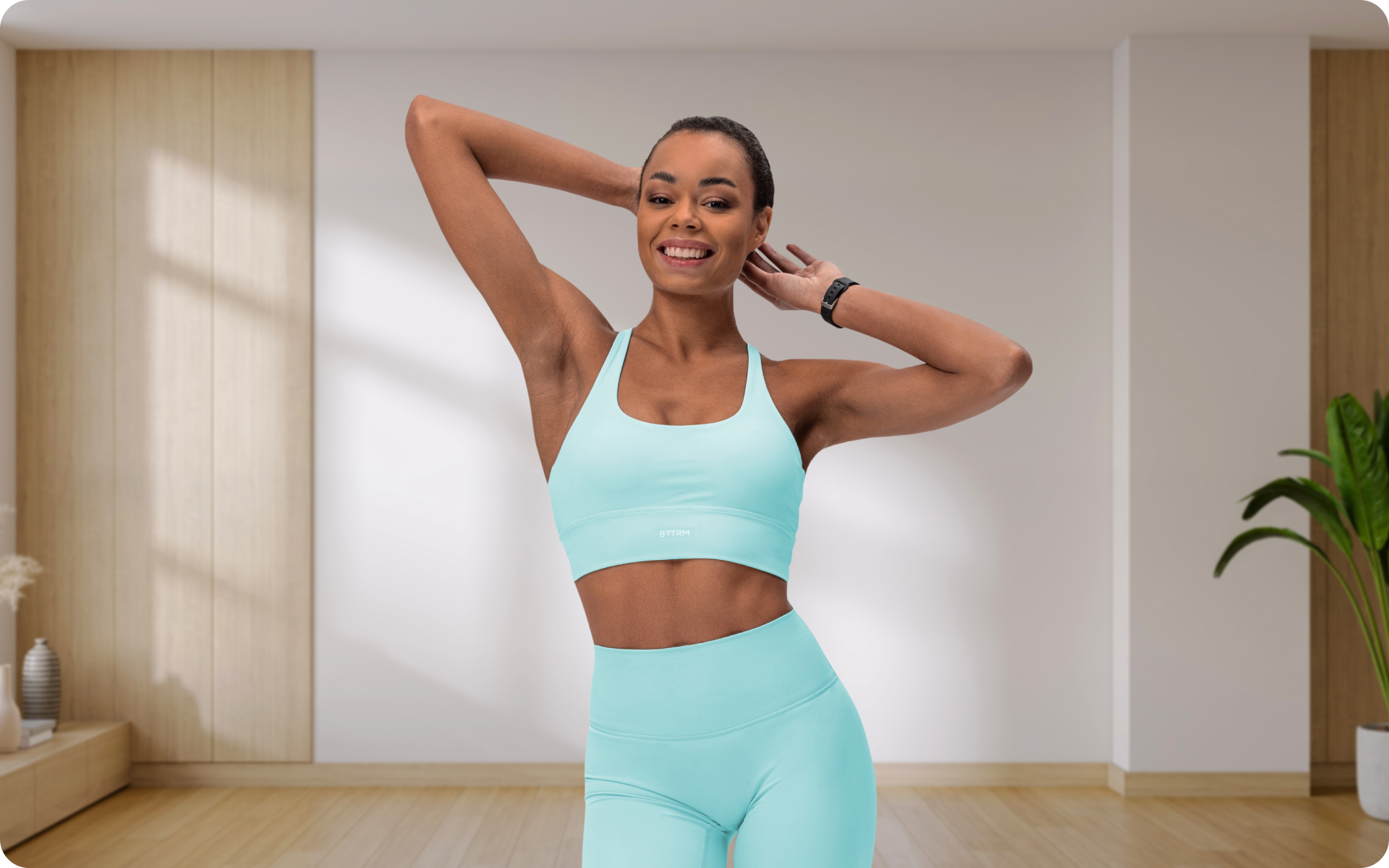Contrary to what many assume, Pilates isn’t limited to specialized studios or equipment. Rather, it can be adapted to any home environment, with minimal gear.
The versatility of this practice allows for modifications to suit your needs. For example, using a wall provides resistance and feedback that can enhance the effectiveness of your movements, while ensuring proper form and alignment. Wall exercises can also be a game-changer in leveling up your routine to become more challenging.
You may even find that wall-assisted Pilates helps in recovering from injuries by enabling better control over balance, coordination, and range of motion.
To make your wall Pilates plan a reality, let’s review the best exercises tailored for all experience levels.
Does The Wall Pilates Plan Work?
A well-structured wall Pilates workout plan (one that targets all major muscle groups) can deliver similar results as traditional Pilates.
The benefits include (6):
- Improved posture: Wall Pilates forces you to pay attention to your spine’s alignment against a flat surface, which can dramatically improve how you stand and sit outside of your workouts.
- Core strengthening: These exercises engage your core like nobody’s business; think tighter abs and a stronger back that can say goodbye to slouching over your computer.
- Balance and stability: By using the wall, you’re not just working out; you’re also training your body to balance better, whether that’s in stilettos or soccer cleats.
- Flexibility: Stretching against a wall helps in lengthening your muscles more effectively, so you’ll be reaching for that top shelf with ease.
- Concentration: Wall Pilates requires focus to maintain contact with the wall during movements, which translates to a more mindful workout.
- Injury Rehabilitation: The support of the wall allows for gentle yet effective workouts, ideal for bouncing back from injuries without overdoing it. However, you must have your doctor’s approval before trying any exercises.
- Variety: There are countless modifications and variations of wall Pilates exercises to keep your routine fresh and challenging.
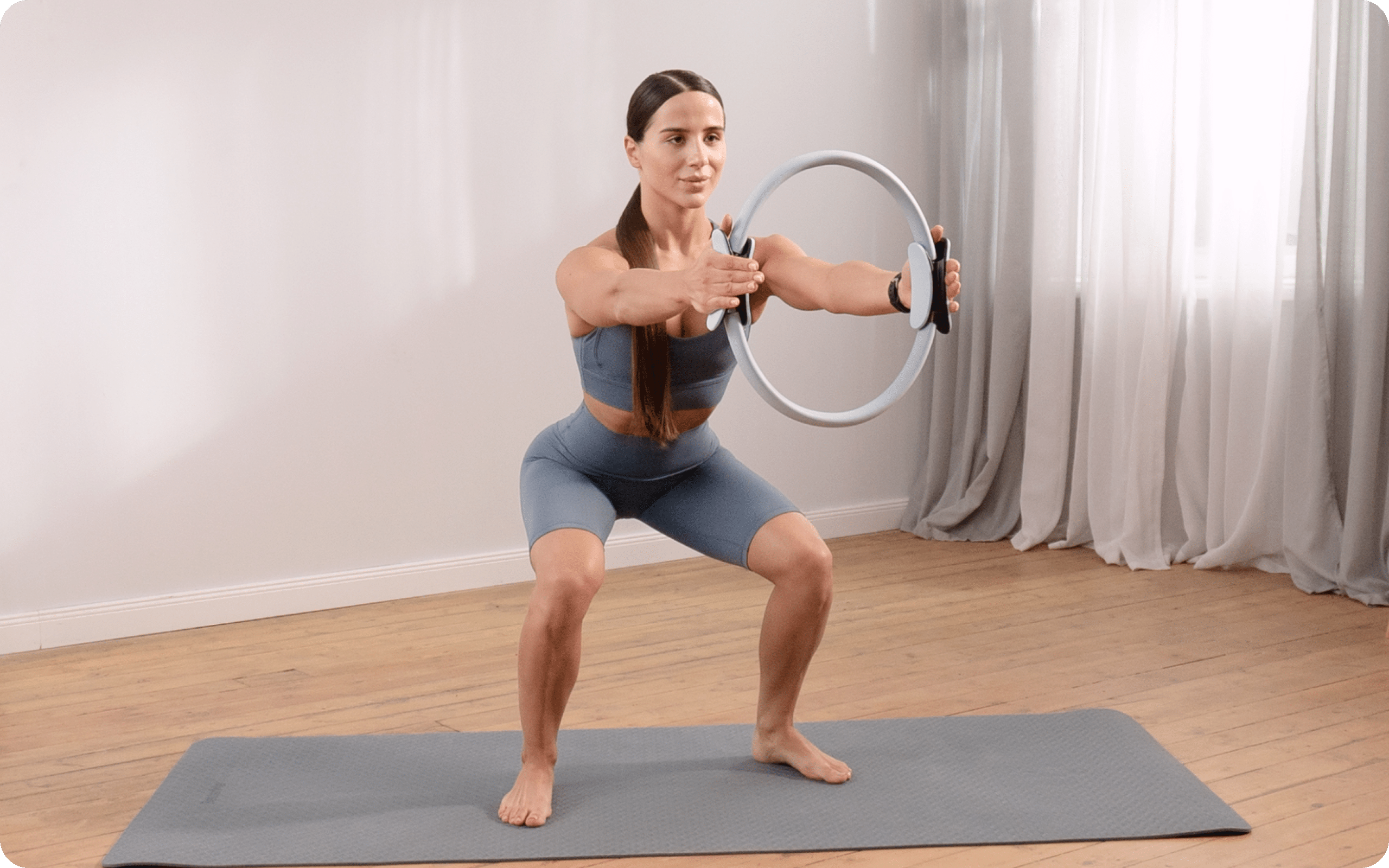
Betterme will keep you laser-focused on your weight loss journey! Nutrient-packed meal plans, fat-blasting workouts, galvanizing challenges and much more. Try using the app and see for yourself!
Can Wall Pilates Help Lose Weight?
A wall pilates plan for weight loss can go a long way in helping you shed pounds. Mainly, because you’ll burn calories while executing each exercise.
Increasing the intensity, duration, and frequency of your workouts will result in a better calorie burn. But, remember that weight loss is a combination of exercise and proper nutrition (7).
Following your wall Pilates plan consistently over time can result in better body composition (1) (where you’re gaining muscle and losing fat), as opposed to just focusing on the number on the scale.
Having more muscle means a higher metabolism, which translates to burning more calories at rest (2).
This 30-Minute Wall Pilates Workout has some inspiration for weight loss.
What Is The Best Wall Pilates Plan?
The best wall Pilates plan is one that suits your needs as far as the frequency, intensity, and duration of your workouts go.
Here’s some guidance to help you set up your wall Pilates workout plan:
Frequency – How Often Should You Do Wall Pilates?
In his original book, Joseph Pilates recommends doing the exercises four times a week, for optimal results. That said, you can adjust the frequency to fit your schedule and fitness level.
Beginners should start with two or three sessions a week, gradually increasing as they build strength and endurance. Intermediate and advanced practitioners could aim for four to six times weekly.
Duration – How Long Should Your Wall Pilates Sessions Be?
Again, this depends on your starting point. If your goal is to complete the full workout, allocate 45 minutes or so. In case you’re short on time, a 20-30 minute routine can be equally effective.
But don’t get caught up on the duration; instead, focus on executing each move with proper form and control.
Intensity – How Hard Should You Push Yourself During Wall Pilates?
You should aim for a level of intensity that challenges you without compromising your form.
If you’re just starting, begin with the basic movements and gradually work your way up to more advanced variations. Listen to your body and modify accordingly.
A good rule of thumb is to aim for a burn or fatigue in your muscles by the end of each exercise, while still being able to maintain proper form.
Don’t worry if you can’t feel the famous “Pilates burn” straight away; it takes time to build the necessary mind-muscle connection.
Exercise Choice – What Exercises Should You Include In Your Wall Pilates Plan?
You could start with some of the original moves created by Joseph Pilates, such as the wall roll-downs, leg circles, and side-lying leg lifts.
As you advance, incorporate more challenging exercises like the wall plank or squat series.
Also, don’t forget to mix in some balance work with movements like the one-legged wall push-up or standing split stretches.
Which exercises you choose depends entirely on your goals and fitness level, so don’t be afraid to experiment and find what works best for you.
Wall Roll-Up Into Bridge
This exercise engages the core, glutes, hamstrings, and lower back, enhancing core stability and lower body strength.
Execution Steps:
- Lie on your back with your feet flat against the wall, knees bent at 90 degrees.
- Press your arms flat on the floor, and as you inhale, begin peeling your spine off the floor starting at your tailbone.
- Keep rolling up until you reach a bridge position with your shoulders, hips, and knees in a straight line.
- Hold briefly, then exhale and slowly roll your spine back down to the starting position.
- Repeat for the desired number of reps.
Kneeling Side Leg Lift
This Pilates exercise focuses on the outer thighs, hips, and obliques. It is great for toning and shaping these muscle groups.
Execution Steps:
- Kneel on the floor with your side to the wall, keeping your palm on the wall at shoulder height for stability.
- Keeping your body in a straight line, lift the leg that’s furthest from the wall sideways and upward.
- Lower your leg back down with control.
- Perform a set on one side, then switch to the other leg.
Read more: Wall Pilates for Butt: A Quick Guide for Beginners
Single Leg Bridge with Abduction
This exercise primarily targets the glutes, hamstrings, and inner thighs. It’s effective for strengthening and sculpting the lower body.
Execution Steps:
- Begin in a bridge position with your upper back on the floor and feet against the wall, hip-width apart.
- Lift one foot off the wall, keeping your leg vertically aligned.
- Push through the heel of the supporting leg, squeeze your glutes, and lift your hips.
- While your hips are lifted, move the lifted leg outward (abduction), then back in.
- Lower your hips to return to the starting position and repeat before switching legs.
Wall Sit with Calf Raise
The Wall Sit with Calf Raise works the quadriceps, glutes, and calves, promoting lower body endurance and strength.
Execution Steps:
- Stand with your back against the wall, feet shoulder-width apart and out in front of you.
- Slide your back down to come into a seated position, knees bent at a 90-degree angle.
- As you maintain the wall sit, lift your heels off the ground, rising onto your toes.
- Lower heels back down with control.
- Repeat the calf raises while maintaining the wall sit position.
Side Plank with Rotation
The Side Plank with Rotation provides an intense workout for the core, specifically targeting the obliques, shoulders, and side abs.
Execution Steps:
- Start in a side plank position with one forearm on the floor and your feet flat against the wall.
- Stack your legs and hips, and extend your free arm towards the ceiling.
- Rotate your torso and thread your extended arm underneath your body while maintaining hip stability.
- Reverse the motion to return to the starting position.
- Complete as a timed exercise, then switch to the other side.
In our Guide to Wall Pushups, we offer a different alternative for targeting similar muscles.
Standing Glute Kickback
This exercise focuses on the lower back, glutes, and hamstring muscles, helping improve posture and back strength.
Execution Steps:
- Start in a standing position facing the wall, hands positioned on the wall at shoulder height.
- Extend one leg back, kicking the heel up and out to create tension in the glutes.
- Hold for a moment, then return your knee to the starting position without touching the floor.
- Repeat for the desired number of reps before switching legs. To increase the intensity, bend at the hips so that your torso is more parallel to the floor.
How to Build Wall Pilates Plan
To build your wall Pilates plan, follow these steps:
- Choose a workout duration that fits your schedule and fitness level.
- Select exercises that target all major muscle groups and incorporate modifications as needed.
- Set realistic goals for yourself, such as increasing the number of repetitions or trying more advanced variations of exercises over time.
- Listen to your body, take breaks when needed, and always prioritize proper form over intensity.
- Incorporate stretching and balance exercises in addition to core strengthening moves for a well-rounded workout.
- Mix in some variety by trying new exercises or increasing the difficulty of familiar ones.
- Remember to consult with your doctor before starting any new exercise routine, especially if you have previous injuries or health conditions.
By following these steps and staying consistent, you can build a customized wall Pilates plan that will help you achieve your fitness goals.
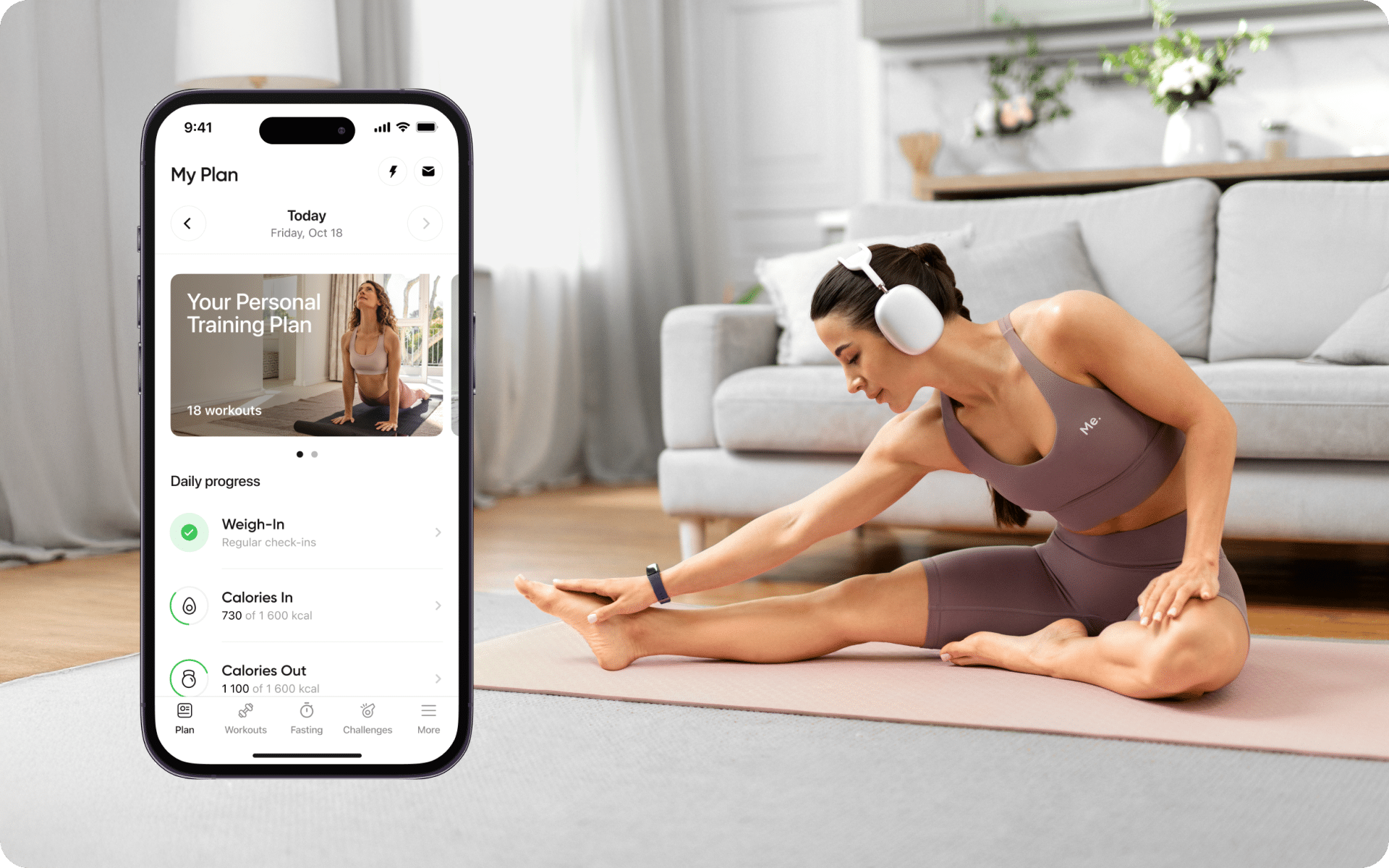
What Is The Best Wall Pilates Plan for Beginners?
Beginners need to start slow and focus on building a strong foundation before progressing to more advanced exercises.
Here’s an example of a simple yet effective wall exercise plan for beginners:
- Warm-up (5 minutes)
- Wall Roll-downs (3 sets of 10 repetitions)
- Side-lying Leg Lifts (3 sets of 10 repetitions on each side)
- Squat series (3 sets of 10 repetitions)
- One-legged Wall Push-ups (3 sets of 10 repetitions on each side)
- Standing Split Stretches (3 sets of 10 repetitions on each side)
- Cool down and stretch (5 minutes)
The idea is to tune in to your body and adjust the number of repetitions or sets as needed. As you progress, try incorporating more challenging variations and increasing the workout duration.
BetterMe app will kick you out of the mental funk, shake off your extra weight, rid you off your energy-zapping habits, and help you sculpt the body of your dreams. Intrigued? Hurry up and change your life for the better!
What Is The Best Advanced Wall Pilates Plan?
Those who’ve advanced in their pilates practice (meaning, they have mastered the basics and have built substantial strength and control) can try incorporating more challenging exercises into their routine.
Here’s an example of an advanced wall Pilates plan:
- Warm-up (5 minutes)
- Wall Plank (3 sets, holding for 30 seconds each)
- Leg Circles (3 sets of 10 repetitions on each side)
- Side Lunges with Twist (3 sets of 10 repetitions on each side)
- Plank with Leg Lift (3 sets of 10 repetitions on each side)
- Wall Roll-up (3 sets, holding for 30 seconds each)
- Cool down and stretch (5 minutes)
You may also choose to increase the duration of your workout and add in some balance work, like the standing split stretches or one-legged wall push-ups.

FAQs
How Effective Are Wall Workouts?
Wall workouts are highly effective, as they involve using your own body weight for resistance and require core engagement throughout the entire routine.
In addition, the Pilates method emphasizes proper form and control, which helps prevent injuries while improving overall strength and flexibility (4) (5).
Does Wall Pilates Tone Your Body?
Wall Pilates may strengthen your muscles while increasing overall tone (3), but that depends on many factors like your starting point, frequency of workouts, and nutrition.
Having a low body fat percentage is crucial for toned muscles to show, so incorporating a balanced diet and regular cardio exercises can help achieve the desired results.
We have a guide to Wall Stretches that may interest you.
Can You Do Wall Pilates At Home?
You can do wall Pilates at home, as long as you have access to a wall and enough space for movement.
There are countless online resources and videos that can guide you through a full wall Pilates routine from the comfort of your own home.
The Bottom Line
Having a Wall Pilates plan and executing it consistently, can result in numerous physical benefits and improved overall well-being.
Whether you’re a beginner or have advanced in your practice, there are exercises suitable for all fitness levels.
Tune in to your body, and prioritize proper form over intensity to achieve your fitness goals with this practice.
DISCLAIMER:
This article is intended for general informational purposes only and does not serve to address individual circumstances. It is not a substitute for professional advice or help and should not be relied on for making any kind of decision-making. Any action taken as a direct or indirect result of the information in this article is entirely at your own risk and is your sole responsibility.
BetterMe, its content staff, and its medical advisors accept no responsibility for inaccuracies, errors, misstatements, inconsistencies, or omissions and specifically disclaim any liability, loss or risk, personal, professional or otherwise, which may be incurred as a consequence, directly or indirectly, of the use and/or application of any content.
You should always seek the advice of your physician or other qualified health provider with any questions you may have regarding a medical condition or your specific situation. Never disregard professional medical advice or delay seeking it because of BetterMe content. If you suspect or think you may have a medical emergency, call your doctor.
SOURCES
- Efficacy of Pilates in Functional Body Composition: A Systematic Review (2022, mdpi.com)
- Increasing muscle mass to improve metabolism (2013, ncbi.nlm.nih.gov)
- Pilates: how does it work and who needs it? (2011, ncbi.nlm.nih.gov)
- Pilates (2011, ncbi.nlm.nih.gov)
- Pilates for Improvement of Muscle Endurance, Flexibility, Balance, and Posture (2011, journals.lww.com)
- The Remarkable Health Benefits of Wall Pilates Exercise (2023, medium.com)
- Weight loss – a healthy approach (2022, betterhealth.vic.gov.au)

